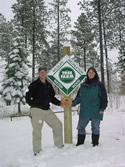Status of MPB north of Red Feather Lakes (Larimer County)The focus in the Fort Collins area since late summer 2008 has been on Mountain Pine Beetle "oddities" to the extent that I felt it was time for a day outside city limits to check out the "norms". By "oddities" I mean odd hosts (predominantly Scots), odd development timing (apparently early flight and attacks in July or even earlier, late flight and attacks in August/early September, advanced brood, pupal chambers being constructed in early November, early emergence of adults of unknown provenance), odd fading patterns (trees with pupating larvae under the bark that still have green foliage), odd levels of adult survival, odd beetle sources (apparently 50+ miles away that got here by wind-assist), odd pitch tube appearance and flow (tubes that look like those of unsuccessful attacks (big, runny) that overtop very successfully developing beetles under the bark, etc.). It is easy to lose perspective when all one dwells on are abnormalities. Sort of like trying to figure out what the world is like by watching TV only.
I am not sure if looking at a dozen or so ponderosas today constitutes a fair assessment of "normal", but here is what I found north of Red Feather Lakes on Larimer County Road 179 (Cherokee Park/Prairie Divide area):
Along 80C (Cherokee Park Road) well west of US287 and all along Road 179 from 80C down to Red Feather Lakes were lots of small ponderosa fader groups (predominately 5 trees or less in size). I have heard the Larimer County Forester Dave Lentz, the ranch manager at CSU's Maxwell Ranch near Red Mountain, former USFS entomologist and aerial surveyor Bill Ciesla, and a few landowners say there are beetles in ponderosa up north and west of Fort Collins. The aerial surveys have not shown this all that much, at least thru 2007. I am not privy to the 2008 survey but my verbal conversations with the CSFS entomologist Ingrid Aguayo indicated there was not a significant population in ponderosa pine as indicated by the 2008 flight. Apparently it took one more period of months to allow enough fading to show the true extent of what is going on. Such is the nature of aerial surveys - always a year behind, plus all the lag time to get the results out. These limitations aside, I respect the skill and dedication of the folks who do the surveys. But after today, I officially agree/admit an epidemic in ponderosa pine seems to be in its early stages in the native forests of the northern Front Range. We will never know if the origin of these beetles was: 1) natural, incremental spread from lodgepole pines not too far to the west, 2) the result of large numbers of lodgepole beetles being blown in freak winds from far to the west, or 3) a natural build-up of an endemic ponderosa pine population responding to a forest that is getting old and dense enough to support a ponderosa epidemic. If the situation up north of Fort Collins fizzles out in the next few years, the answer to the question of source might be #2. If the epidemic spreads south to Denver, the Black Forest, and beyond, like it did in the 1970's, the answer to source is probably #3, maybe #1.
The predominate life stages in the trees I checked on 16June2009 were about equal numbers of pupae and light-brown, freshly-formed, "callow" adults. I also found a few late-stage larvae, a few black adults that appeared to be from last summer's attacking generation that survived the winter, a few very small larvae, and even a few eggs. Before chopping on the first tree that was just beginning to turn color, I asked what would be expected. The answer was "fat larvae, some pupae, and maybe a few callow adults". Basically the prediction was correct, with things being a week or two on the advanced side. If what I saw today is typical, it looks like the peak emergence north of Red Feather Lakes from ponderosa pine will be in about 3-4 weeks. That is about what would be typical of lodgepole pine. That is, begin in early July, peak in mid to late July, with a few dribbling out in early August. The ponderosa peak is usually in early August at the elevation I was today. My bet is that most of the beetles will be out of red ponderosa pines and in a new crop of green trees about two weeks earlier than what we think of as the historical norm.
Getting back to the small larvae and eggs, they were in just one tree that was dark green and showed what appeared to be fresh pitch tubes. The tubes were large, very gooey, and reddish. There was a little bit of fresh boring dust at the base of this tree. The egg galleries were about 5 inches long, the bluestain well-developed. The larvae were very small (the way they should look in September or October, about a month or so after egg hatch). Holes in the bark not associated with pitch tubes appeared to be ventilation holes originating from the egg galleries, NOT emergence holes made by brood originating at pupal chambers. So, how would I interpret this? It looks like an attack that occurred late this spring and one I'd say the jury is still out on regarding its ultimate success. The tree may die of the attacks it has sustained to date, but it probably won't. But if it gets reattacked in about a month, it will very likely die. In other words, perhaps it is like one of those "oddities" in Fort Collins that appears to have sustained two strangely-timed attacks prior to dying and that caused all the confusion.
In summary, the MPB population in ponderosa along the northern Front Range, as has been suggested before now by others, has flipped the switch from endemic to early epidemic. This should NOT be a call to panic. Ponderosa pine is not lodgepole pine. Timing-wise, the beetle world is still in order and our management schedules are proper, but there is a small subset of the population that I would call out of synch. Maybe the % of beetles out of whack is the same as always and because the population at present is large, the fringe beetles get detected more often. I don't know. If the % of asynchrony is larger than normal, hopefully it is a dead-end street that Nature will take care of when we have a "real" Colorado winter.
Dave Leatherman Forest Entomologist Fort Collins
|



